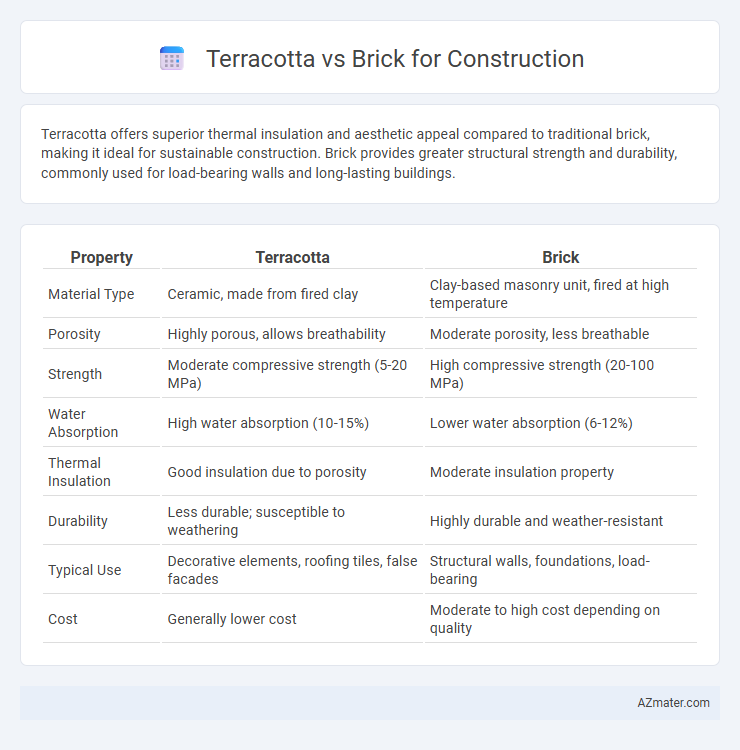Terracotta offers superior thermal insulation and aesthetic appeal compared to traditional brick, making it ideal for sustainable construction. Brick provides greater structural strength and durability, commonly used for load-bearing walls and long-lasting buildings.
Table of Comparison
| Property | Terracotta | Brick |
|---|---|---|
| Material Type | Ceramic, made from fired clay | Clay-based masonry unit, fired at high temperature |
| Porosity | Highly porous, allows breathability | Moderate porosity, less breathable |
| Strength | Moderate compressive strength (5-20 MPa) | High compressive strength (20-100 MPa) |
| Water Absorption | High water absorption (10-15%) | Lower water absorption (6-12%) |
| Thermal Insulation | Good insulation due to porosity | Moderate insulation property |
| Durability | Less durable; susceptible to weathering | Highly durable and weather-resistant |
| Typical Use | Decorative elements, roofing tiles, false facades | Structural walls, foundations, load-bearing |
| Cost | Generally lower cost | Moderate to high cost depending on quality |
Introduction to Terracotta and Brick in Construction
Terracotta and brick are both traditional building materials widely used in construction for their durability and aesthetic appeal. Terracotta, a type of fired clay, is known for its distinctive reddish-brown color and is often used for decorative facades, roofing tiles, and architectural details due to its natural insulation properties and weather resistance. Bricks, made from clay or shale, offer structural strength and versatility, making them a fundamental material in walls, pavements, and load-bearing applications across residential and commercial buildings.
Historical Usage of Terracotta and Brick
Terracotta has been historically utilized since ancient times, notably in Mesopotamian and Indus Valley civilizations, valued for its versatility in decorative architectural elements and durable pottery. Bricks, dating back to around 7000 BCE in Neolithic cultures, became a cornerstone of construction in Egypt, Rome, and later medieval Europe, prized for their structural strength and uniformity. The evolution of terracotta primarily enhanced ornamental applications, while brick maintained dominance in foundational construction due to superior load-bearing capacity.
Composition and Manufacturing Processes
Terracotta is made from refined clay that is shaped and fired at lower temperatures, resulting in a porous, reddish-brown material primarily used for decorative facades and roofing. Bricks consist of clay or shale mixed with sand and other additives, molded and fired at higher temperatures to create dense, durable building blocks ideal for structural walls and foundations. The manufacturing process of terracotta involves handcrafting or molding with intricate designs before firing, while brick production typically uses automated molding and kiln firing to ensure uniform strength and size.
Aesthetic Differences: Color, Texture, and Finish
Terracotta offers warm, earthy tones with a natural reddish-brown color that ages beautifully, adding rustic charm to architectural designs. Bricks provide a broader color palette, from deep reds and browns to yellows and grays, allowing versatile aesthetic applications. Texturally, terracotta features a smoother, matte finish with subtle grooves, while bricks have a coarser surface and varied finishes like glazed or sand-faced, influencing the visual and tactile experience of building facades.
Structural Strength and Durability Comparison
Terracotta exhibits high compressive strength and excellent resistance to weathering, making it a durable choice in construction, especially for decorative facades and non-load-bearing applications. Bricks, particularly fired clay bricks, provide superior structural strength and load-bearing capacity, which is ideal for foundational walls and heavy structural components. While terracotta offers enhanced aesthetic versatility, bricks outperform in long-term durability and resistance to mechanical stress in structural applications.
Thermal Properties and Energy Efficiency
Terracotta offers superior thermal insulation due to its porous structure, which effectively reduces heat transfer and stabilizes indoor temperatures, enhancing energy efficiency in buildings. Bricks, while durable, typically have higher thermal conductivity, which can lead to increased heat gain or loss, raising cooling and heating demands. Utilizing terracotta in construction can significantly lower energy consumption by improving thermal regulation and reducing reliance on HVAC systems.
Resistance to Weather and Environmental Factors
Terracotta exhibits superior resistance to weather and environmental factors due to its natural clay composition, which provides excellent durability against moisture, temperature fluctuations, and UV exposure. Bricks, while strong, may absorb water more easily unless specially treated, leading to potential issues like spalling or efflorescence in harsh weather conditions. Terracotta's porosity and firing process enable it to withstand freeze-thaw cycles better than conventional bricks, making it a preferred choice for exterior cladding in variable climates.
Cost Differences: Material and Installation
Terracotta generally incurs higher material costs compared to standard bricks due to its specialized manufacturing process and aesthetic appeal. Installation expenses for terracotta can also exceed those of brick, given the need for skilled labor to handle its fragility and unique fitting requirements. Conversely, bricks offer more economical pricing and faster installation, making them a cost-effective choice for large-scale construction projects.
Sustainability and Environmental Impact
Terracotta offers superior sustainability in construction due to its natural clay composition, low energy consumption during production, and excellent thermal insulation properties, reducing long-term energy use. Bricks have a higher carbon footprint primarily because of the intense firing process and higher raw material extraction, although innovations in eco-friendly brick manufacturing are emerging. Choosing terracotta can significantly lower environmental impact by enhancing building energy efficiency and using biodegradable materials.
Choosing the Right Material: Application Suitability
Terracotta is ideal for decorative facades and lightweight cladding due to its natural insulating properties and aesthetic versatility, while bricks offer superior structural strength and durability for load-bearing walls and foundational work. Selecting between terracotta and brick depends on the construction's functional requirements, climate conditions, and long-term maintenance considerations. In regions prone to moisture, bricks provide enhanced resistance, whereas terracotta suits projects prioritizing thermal regulation and architectural detail.

Infographic: Terracotta vs Brick for Construction
 azmater.com
azmater.com